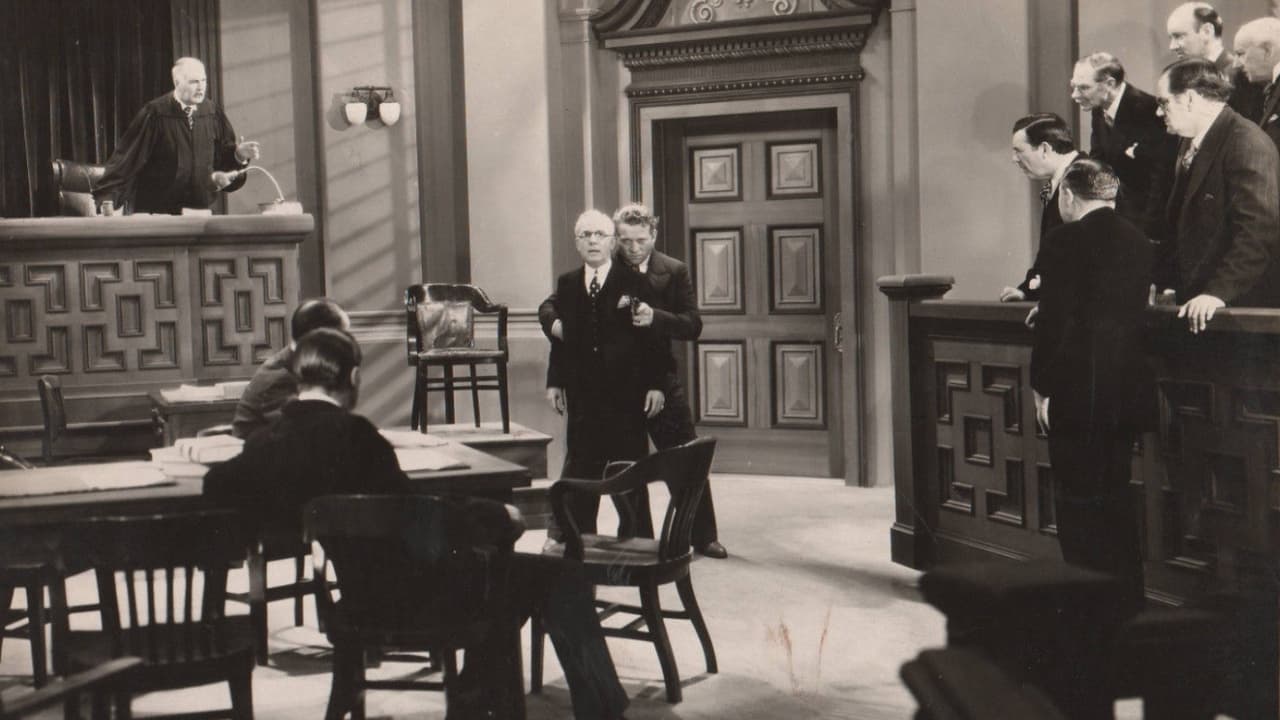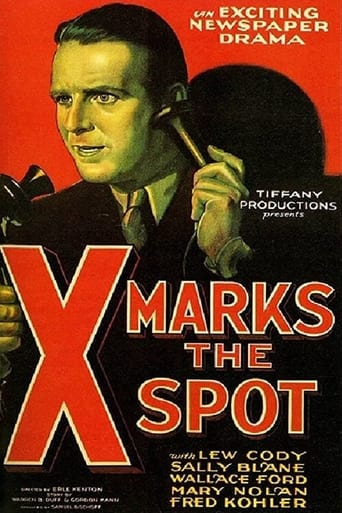

This B-movie is from the ill-named 'Tiffany Productions'. Unlike the famous store of the same name, Tiffany Productions was anything but high-class and fancy! It was a so-called 'Poverty Row' studio....folks who rented space at other larger studios and filmed at night to economize. Most of their films are okay...nothing special...and nothing like the name would imply.Ted Lloyd (Wallace Ford) is a newspaper reporter for The Gazette. This job pays fine but not well enough. This is because Ted's young sister is in desperate need of surgery....and it will cost $5000 (the average pay back then was about $1000 a year). He tries all the legitimate sources he can for a loan and the only one that will give him the money is a shifty character named Riggs. Being in a pinch, Ted accepts the money.Eight years pass. When Ted is out working, he visits a woman about a story. Soon after, she's found dead and the police assume he's guilty since he's the last known person to see her. So Ted decides to try to solve the crime himself. Unfortunately, the trail leads to Riggs!! What's next? See the film.During the 1930s, Wallace Ford made a bazillion B-movies. While far from being a handsome leading man, his films are generally agreeable and he played a nice 'every man' sort of character in most of them...and often played snappy reporters. This is yet another one of these films and it does feature an interesting plot....and an interesting dilemma. And, the movie is better than I've come to expect from Tiffany. Usually their movies are pretty limp...at best.
... View MoreThis intriguing crime melodrama opens in 1923 when reporter Ted Lloyd's (Wallace Ford) kid sister is involved in a hit and run and he moves heaven and earth to try to raise the $5,000 needed to send her to a top German specialist. He finally gets the money from racketeer Ed Riggs (Fred "why bother talking when shouting will do"!! Kohler) and as Ted says "I'll never forget this"!! Eight years later he is the top society gossip reporter of the Great White Way who is in an uphill battle trying to persuade haughty follies beauty Vivyan Parker not to sue for defamation!!Two ravishing beauties appear as the ying and yang of typical pre-code heroines. Mary Nolan, once a fabulous Ziegfeld beauty, by 1931 was on a downward spiral. She had been banned from the Universal lot for erratic behaviour and now faced a career on poverty row. And judging by her role in this - her reputation proceeded her as she had the minimum of screen time. She plays the beauteous Vivyan and after her own "big scene" (and Mary gives it all the emotion she has) where she has it out with Ted, she is found dead in her apartment and it is that murder that brings back the past to haunt him. A big X marks the spot where the body is found!!Playing the role of the love struck reporter was Sally Blane, equally beautiful sister of Loretta Young. Her career wasn't as equally fabulous though and while Loretta was being given the star treatment at First National, Sally was languishing at studios like Tiffany and Peerless. Ted finds out that the real murderer is Riggs ("she had it coming - she was a tramp"!!) Ted swears that he will not turn him in, loyalty is too important to him, but someone overhears the conversation - it is Gloria, Ted's little sister, she doesn't think of what she owes Riggs, only that her brother must be saved!! She is played in a pretty wooden way by Joyce Coad who was memorable as the child in Lillian Gish's "The Scarlet Letter". Helen Parrish played Gloria as a little child, she later went on to have a teen career in the late 1930s (playing Deanna Durbin's mean step sister in "First Love" (1939)). I agree Wallace Ford was great in this movie, he always seemed to have a professionalism that was obviously with him from the start.Top billed Lew Cody was a very in demand silent star during the early talkies, his suave looks made him a natural as a night club owner or racketeer - here he played Ted's boss. Charles Middleton played a detective chief and even though Clarence Muse was just an elevator operator he always gave a film class. Fred Kohler had a real presence as the tough hood, his whole demeanor commands attention - not to mention his voice!!!Highly Recommended.
... View MoreAlthough Lew Cody and Sally Blane are billed over Wallace Ford, this is his film, and only his second full-length one to be released, back in 1931. To a large extent, it is a near FRONT PAGE type of tale, with Cody as the fast-talking and near-conscienceless editor and Ford as his ace reporter, and they are not all that inferior to their more famous film counterparts as played by Adolphe Menjou and Pat O'Brien. Not only that, but the various scenes in the newspaper office(s) they inhabit are about as atmospheric and realistic as anything of their type I have seen in film, then or now, and director Erle C. Kenton uses some really impressive tracking shots encompassing huge amounts of space, actors, and dialog that Alfred Hitchcock might have been proud of. When there is action, it is fast-paced, and both the newspaper offices and courtroom episodes, as well as the many street scenes featured, involve a great many actors, extras, vehicles, etc., so this looks like anything but a 1931 B film. Lew Cody had been a big star in silents, and he has a rather middle-aged debonair look about him entirely at odds with his tough and masculine speaking voice. Indeed, his hat (shades of the kind that Leslie Fenton and Dwight Frye might have affected) would have had my dad questioning his masculinity, if not for his totally macho delivery of his lines. Ford, given a role here with a bit more sentimentality than was usual for him (or for reporters at all in those McArthur/Hecht-influenced days) carries the film on his shoulders very well. Sally Blane as his girl friend (and Cody's secretary) carries her parts of the film better than could most actresses in the still nascent 1931 spoken performance style expected of leading ladies back then (she's certainly more realistic and natural than, say, Jean Harlow in that same year), and everybody else is just fine, including villainous Fred Kohler in an unusual non-Western role, Charles Middleton as a not overly bright police inspector with no signs yet on display of his Ming the Merciless immortality grab a few years later (this same year he was also a much smarter prosecutor in AN American TRAGEDY), and Clarence Muse (misspelled "Meuse" here, and maybe the best African-American actor in early sound films before Paul Robeson's arrival) in a very good and funny, if somewhat stereotypical (for the times) black role as a witness who, while answering questions in a not too bright manner, is seen to easily have more brains than the inspector and the district attorney who question him both at the murder scene and on the witness stand. Example: Called back to the witness stand, the prosecutor says, "You established the fire escape" (referring to previous testimony) and Muse answers, "I didn't establish it; it was there when I got the job." Not Neil Simon perhaps, but still funny in the context of the film, and I would imagine audiences laughed at it. Anyway, a most delightful and interesting way to spend an hour with early Wallace Ford, late Lew Cody (he died in 1934) and lovely Sally Blane, a B-film girl for all seasons who was just as good an actress at this stage of her career as was her sister Loretta Young during the same period. I'm surprised this film isn't better remembered.
... View MoreThis is certainly one of the most unusual of the many reporter-and-crime movies of the 30s - and unfortunately, it seems to have sunk almost into oblivion. Here we've got that genuine, unique newsroom atmosphere, the cheeky, wisecracking reporters who are always after a big headline, with their favorite subject of course a capital crime - but we've also got a LOT more than that: a personal story that links one of the reporters to a well-known crook who, in a wave of compassion and decency, gives him the 5000 dollars that he needs for the operation of his little sister who's been in an accident and otherwise would never be able to walk again...Time passes - and fate brings the two together again: the reporter writes a very revealing article about an important personality having an affair with a showgirl, and she sues the paper for an incredible sum. He goes to her luxury apartment to persuade her to revoke her charge, but fails and leaves - and the next morning the girl is found dead in her living room: 'X marks the spot' on the carpet where she lay - and now the reporter, who was the last one to be seen with her, is suspect number one... Big headlines for his newspaper - but a murder charge for him.He investigates on his own, and notices that there are certain valuable pieces of jewelry missing from the showgirl's possessions; which leads him to - the crook who had helped his sister get well. And what's more: HE's the murderer, as he himself tells him when he asks him to return his favor now and get him some money. Now, in turn, the reporter's conscience awakes, and he agrees and promises him that he won't betray him, even though he faces the same charge...But then again, fate plays a trick on both of them - and the rest really goes beyond any 'usual' reporter crime movie... See for yourself; this is a movie that obviously far too few people have watched - and it's WORTH watching.
... View More